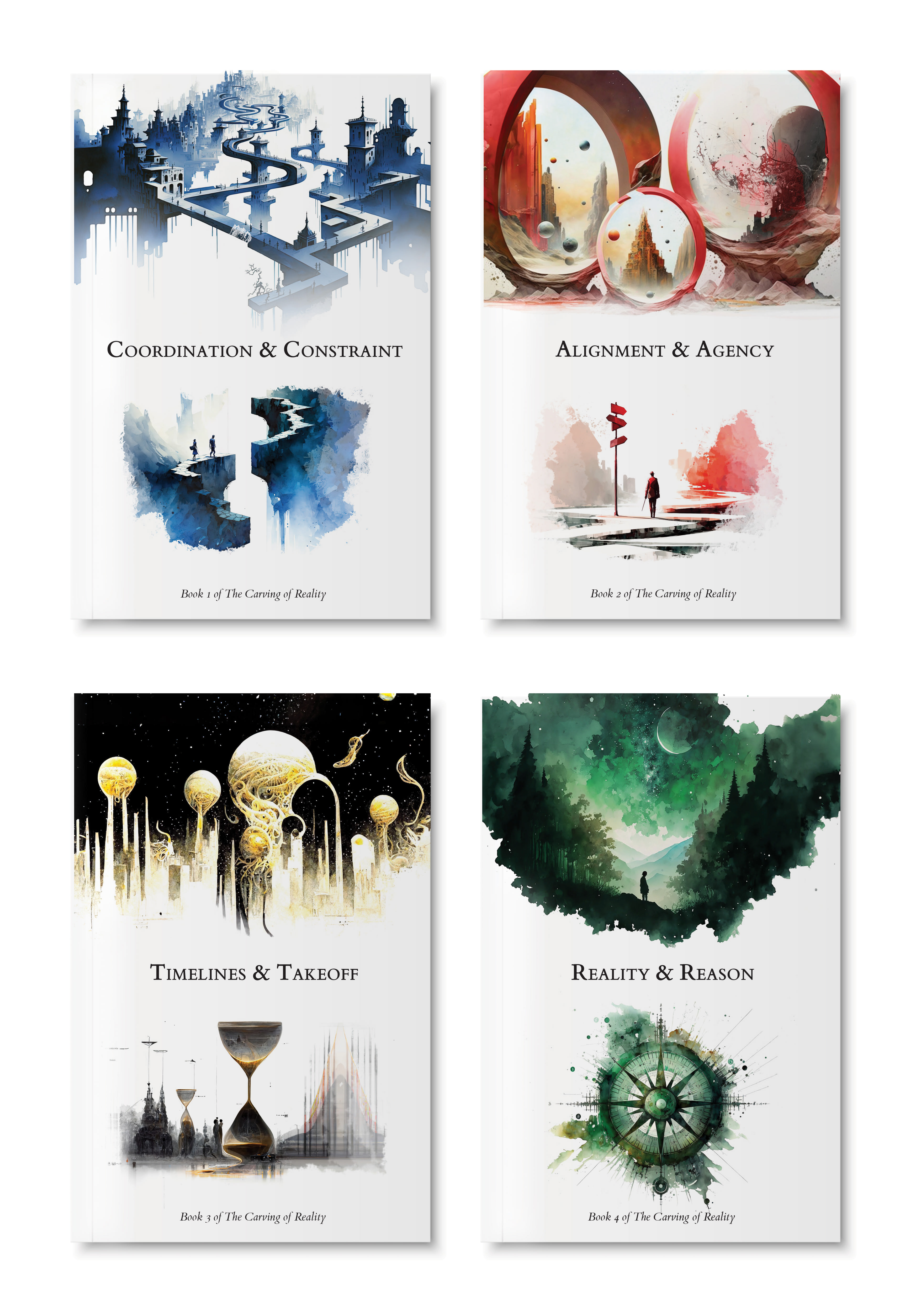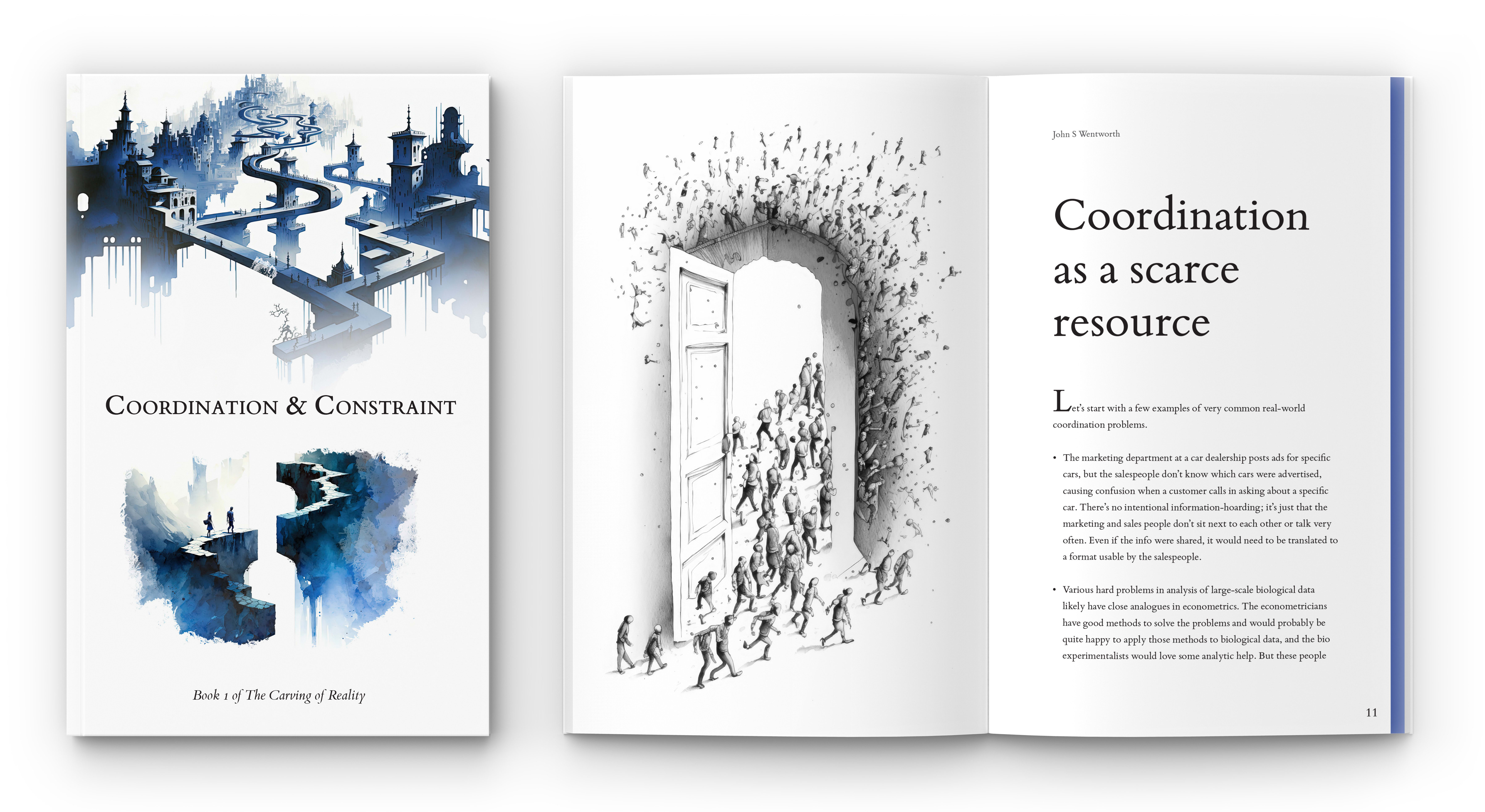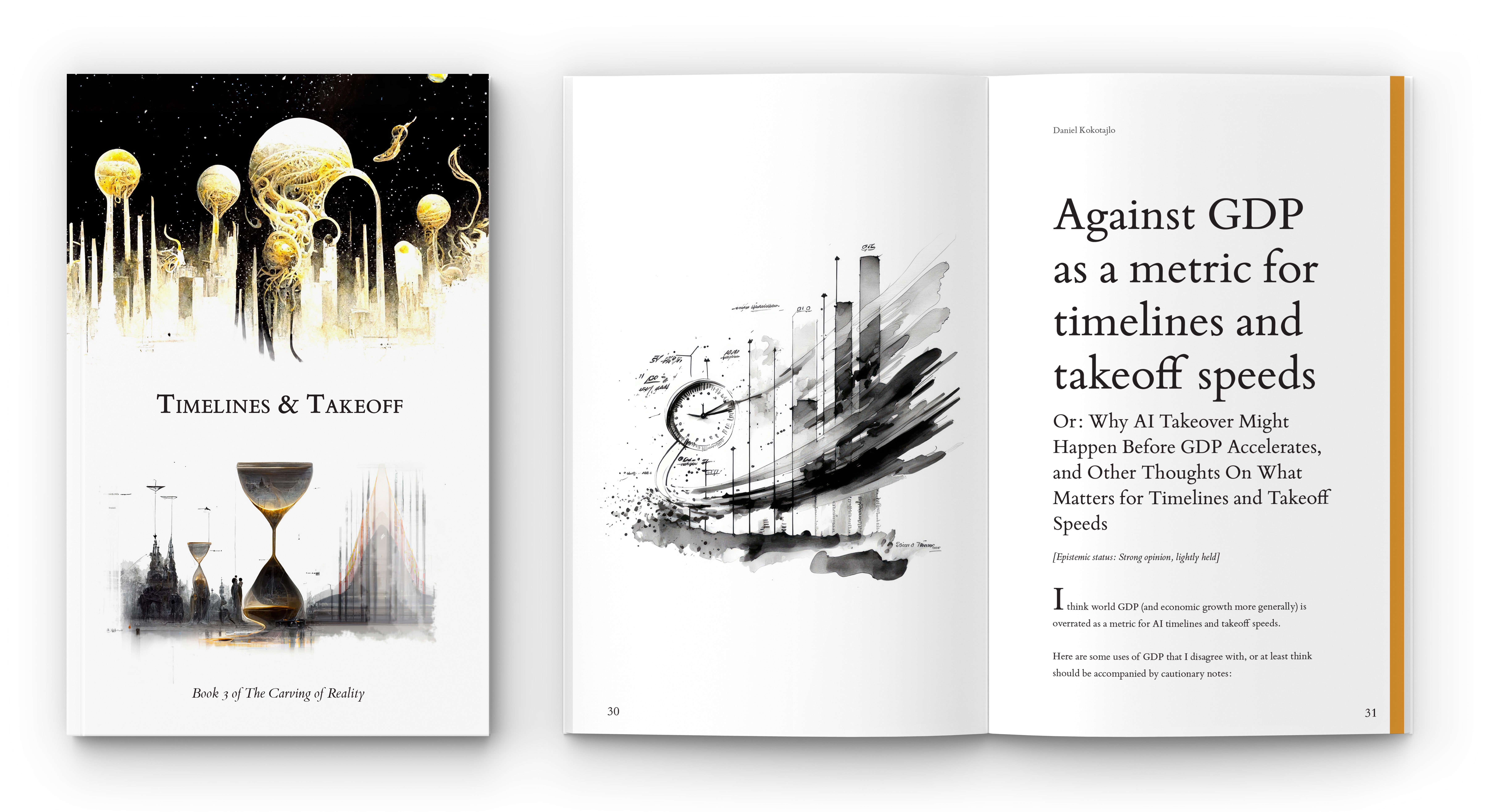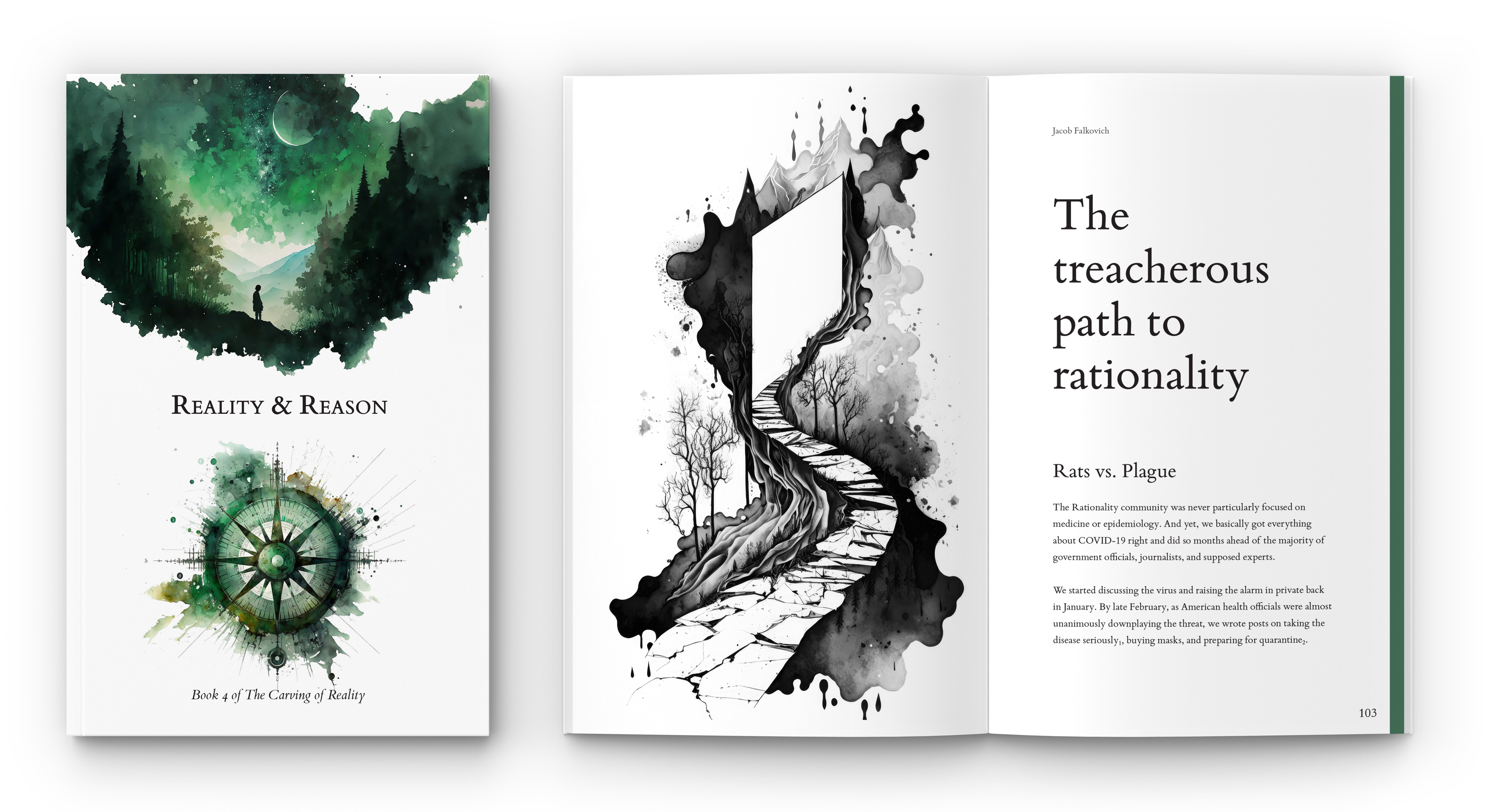Book Launch: “The Carving of Reality,” Best of LessWrong vol. III
The Carving of Reality, third volume of the Best of LessWrong books is now available on Amazon (US).

The Carving of Reality includes 43 essays from 29 authors. We’ve collected the essays into four books, each exploring two related topics. The “two intertwining themes” concept was first inspired when as I looked over the cluster of “coordination” themed posts, and noting a recurring motif of not only “solving coordination problems” but also “dealing with the binding constraints that were causing those coordination problems.”
I’ve included the foreword from “Coordination & Constraint”, which I think conveys the overall spirit and context of the books:
Each year, the LessWrong community votes on the best posts from the previous year, to see which posts have stood the tests of time.
In 2020, the highest ranked post was Catherine Olsson’s announcement of microCOVID.org, a calculator for evaluating COVID risk. MicroCOVID is one of the clearest success stories of the ‘rationalist mindset’ that I know of. Creating it involved research during the early pandemic, when information was scarce, and time was of the essence – a classic situation where the traditional scientific process is inadequate and LessWrong-style rationality tools are valuable. It also required a quantitative mindset, and willingness to assign numbers to risks and make tradeoffs.
But microCOVID.org is most interesting to me as a tool for coordination. It doesn’t just let individuals make better life choices. Microcovid changed the entire covid coordination landscape by relaxing a constraint. Previously, if you lived with people with varying covid-caution preferences, and you wanted to hang out with someone from another house of people with varying covid-caution preferences… your only option was to have fairly involved negotiations on a case-by-case basis. Many people I know grew exhausted from negotiating, and gave up on trying to visit their friends. The microCOVID tool gave people a simplified “risk budget”, letting them do whatever activities made sense to them as long as they didn’t overspend.
“Negotiation energy” was a limiting resource, and microcovid.org made negotiation radically cheaper. It also opened up entirely new options, like “create a household microCOVID tax” (some houses decided that you could do whatever activities you wanted, you just had to pay other housemates $1 per microcovid).
The proximate inspiration for the theme of this book (and included herein) are John Wentworth’s posts “Coordination as Scarce Resource”, “Transportation as Constraint”, and “Interfaces as Scarce Resource.” Other posts explore the nature of particular constraints that society faces – Zvi’s posts on “Simulacra Levels and their Interactions,” “The Road to Mazedom,” and “Motive Ambiguity” each spell out how and why some communication is systematically distorted. And while they don’t give us a solution, they help ask a question – what would need to change, in order for society to coordinate at scale, without incentivizing distorted communication?
COORDINATION & CONSTRAINT

| John Wentworth | Coordination as a Scarce Resource | |
| John Wentworth | Transportation as a Constraint | |
| John Wentworth | Interfaces as a Scarce Resource | |
| Catherine Olsson | MicroCOVID.org | |
| Jacob Falcovich | Seeing the Smoke | |
| Alkjash | Pain is not the unit of Effort | |
| Alkjash | Is Success the Enemy of Freedom? | |
| Zvi Mowshowitz | Simulacra Levels and their Interactions | |
| Zvi Mowshowitz | The Road to Mazedom | |
| Zvi Mowshowitz | Motive Ambiguity | |
| Scott Alexander | Studies On Slack | |
| Jim Babcock, Elizabeth Van Nostrand | Credibility of the CDC on SARS-CoV-2 | |
| Raymond Arnold | ”Can you keep this confidential? How do you know?” | |
| Abram Demski | Most Prisoner’s Dilemmas are Stag Hunts; Most Stag Hunts are Schelling Problems | |
| Martin Sustrik | Swiss Political System: More than You ever Wanted to Know (I.) | |
| Jason Crawford | Why haven’t we celebrated any major achievements lately? |
ALIGNMENT & AGENCY
Essays about how agency works, and how we might successfully build an AI agent more powerful than us that does what we actually want.

| John Wentworth | Alignment By Default | |
| Abram Demski | An Orthodox Case Against Utility Functions | |
| Orthonormal | Choosing the Zero Point | |
| John Wentworth | The Pointers Problem: Human Values Are A Function Of Humans’ Latent Variables | |
| Evan Hubinger | An overview of 11 proposals for building safe advanced AI | |
| Paul Christiano | Inaccessible information | |
| Scott Garrabrant | Introduction to Cartesian Frames | |
| Andrew Critch | Some AI research areas and their relevance to existential safety | |
| Richard Ngo | AGI safety from first principles: Introduction |
TIMELINES & TAKEOFF
Essays about when (and how) powerful technology might permanently alter our world.

| Daniel Kokotaljo | The date of AI Takeover is not the day the AI takaes over | |
| Daniel Kokotaljo | Cortés, Pizarro, and Afonso as Precedents for Takeover | |
| Daniel Kokotaljo | Against GDP as a metric for timelines and takeoff speeds | |
| Scott Alexander | Biological Anchors: The Trick that Might or Might Not Work | |
| Katja Grace | Discontinuous progress in history: an update | |
| Jeffrey Laddish | Nuclear war is unlikely to cause human extinction | |
| Alex Zhu | How uniform is the neocortex? |
REALITY & REASON
Essays about how to build an accurate map that reflects the underlying territory.

| Mark Xu | The First Sample Gives the Most Information | |||
| John Wentworth | What Money Cannot Buy | |||
| Anna Salamon | Reality-Revealing and Reality-Masking Puzzles | |||
| Ben Kuhn | To listen well, get curious | |||
| Kaj Sotala | The Felt Sense: What, Why and How | |||
| Mark Xu | The Solomonoff Prior is Malign | |||
| Jacob Falcovich | The Treacherous Path to Rationality | |||
| Jack H | Anti-Aging: State of the Art | |||
| Alex Flint | Search versus design | |||
| Abram Demski | Radical Probabilism | |||
| Vanessa Kosoy, Diffractor | Introduction To The Infra-Bayesianism Sequence |
FAQ[1]
How do I acquire the books?
The Carving of Reality is available on Amazon (US) for $30.
Are they available in other countries?
Alas, we don’t have the bandwidth to do the logistics necessary to get it formally set up a listing for other countries. (Sorry about this! We did this the first year and it unfortunately turned out to be extremely effort-prohibitive)
How did you make the art?
The art was AI generated, using Midjourney version 4.
Are there any egregious printing errors you’re embarrassed about?
Sigh, yeah. Most notably, we ended up with a misaligned “LessWrong” logo on the spine of the Coordination book. However, some say this simply reality demonstrating that coordination is hard, with one book deciding to do its own thing and ruin the aesthetic for everyone.
Are previous book sets still available?
Yes! You can also buy copies of A Map That Reflects The Territory and The Engines of Cognition.
- ^
By which I mean “questions that nobody has actually asked yet but I vaguely anticipate people asking.”
- GPT-powered EA/LW weekly summary by (EA Forum; 23 Aug 2023 21:23 UTC; 59 points)
- GPT-powered EA/LW weekly summary by (25 Aug 2023 18:19 UTC; 18 points)
- Carving of Reality 1 - LW/ACX Meetup #251 (Wednesday, August 23rd 2023) by (22 Aug 2023 18:27 UTC; 2 points)
- Carving of Reality 3 - LW/ACX Meetup #253 (Wednesday, September 6th 2023) by (6 Sep 2023 5:08 UTC; 2 points)
I wonder if it would make sense to also make a “best before 2018” compilation (excluding the Sequences). The number of articles per year was much smaller, but maybe all of them taken together would be enough.
(Alternatively, maybe include the old articles in the next round, i.e. make it “2021, plus a few ancient articles”. That seems a bit weird, but probably requires much less extra work.)
You can find the previous volumes online at https://www.lesswrong.com/bestoflesswrong .
Wow, that’s a great page! Apparently each book is available as an online sequence, including the ability to track reading progress etc., minus whatever edits have been made to the essays for print publication.
Re: selling books globally: apparently as part of “Fulfillment by Amazon”, there’s an Amazon program nowadays where Amazon does all the international stuff for you, by purchasing inventory from you and then reselling it abroad. The details in Amazon Seller Central Europe are here (login required). I don’t know how well this works, or if a similar program is available in the US.
Anyway, here’s an excerpt:
I just checked, it actually says they’re already enabled.
Thanks. I just checked on Amazon DE and UK, and the book is indeed available for sale there, presumably offered by Amazon buying your own inventory as per the above, and (at least in Germany) they just include shipping and their resale profit margin in the sticker price (rather than e.g. including a separate price for shipping).
Amazon DE: 38€ (~$40), ships to Germany, no idea whether it also ships elsewhere in Europe.
Amazon UK: £27.5 (~$33.5, shipping might not be included), ships to the UK, no idea whether it also ships elsewhere.
Amazon Turkey, Amazon Mexico
Amazon Australia, Amazon Singapore (both listed as item currently unavailable)
(While DE and UK seem cheaper than ordering directly from the US, I haven’t checked the same for the other stores.)
So it might be worth adjusting the answers to the first two questions of the FAQ to sth like: “We only directly sell on Amazon US. Plus Amazon might conceivably sell the books, with no input from us, in your country’s local Amazon store; here are links to the stores we’re aware of. If the books are not available in your country’s Amazon store, try briefly googling them, and if none of the Amazon stores (incl. Amazon US) ship to you, then they’re unfortunately not available”.
(I hadn’t checked before now because I’ve just already spent a ton of time doing book admin this year and was fairly exhausted from it. )
You definitely want to read these as physical books if the option is available. Screens are distracting, there’s the inescapable urge to create a new tab to do whatever, basically whenever you spend even a second not feeling super engaged (doesn’t matter what causes that second). There’s also even worse reasons that I’m not willing to mention in public.
Zvi also makes a solid case for why smartphones are terrible here.
Counterpoints to reading physical books:
The ability to highlight digital text is leaps and bounds over that of physical text. What’s the point of reading dozens of LW essays if I’m going to forget almost everything therein within months? My memory is particularly bad, but the problem of forgetting most of what one reads is ubiquitous. The recommended remedy for forgetfulness is to use spaced repetition, but how do you generate the cards in your spaced repetition system without digital copyable highlights?
How do you read a physical book in the dark if there’s no backlighting? Of course you can turn on a lamp, but that solution is way worse.
Also, where is text-to-speech in physical books?
I agree that smartphones and browsers are terrible distraction devices, but they’re not without significant advantages. And e-ink readers like the Kindle have some of these advantages, while having less of the corresponding disadvantages of the “smarter” devices.
Questions for the FAQ:
Questions on editing:
During print publication, what kinds of changes, if any, have been made to the essays?
Were there substantial edits?
Are any edited essays considered, by you and/or the author(s), to be significantly “better” than the original online versions?
Who edits these books, anyway?
How much time and effort did it altogether take to create these books?
Were there any other essays which scored highly in the 2020 review, which you would’ve liked to include in these books, but had to cut either for length reasons or otherwise?
I love these book sets and I will keep buying them as they come out. They are also in my list of “books to gift people when the occasions come up”.
Also thank you for putting the first set back into print!
(Also please being back that printed Highlights From The Sequences, that’s my favorite one and I want to gift it to people, but I only got a copy from EAG once. There’s an underrated benefit to giving someone a physical book; Many people feel more psychologically interested in reading a physical book that takes up space (and is designed really well!), but would ignore the same content sent as a web link / index-of-blogposts.)
Yes! I’m quite sad that I’m about to finish the physical “How to Actually Change Your Mind”. I aim to read all of RFATZ but it’s about to be a lot harder when I have to do it on my computer. I hope that the other books will magically come into print exactly when I finish the book.
If this book was just published, why is the publication date on Amazon set to January 1, 2023? And is the print length really exactly 1000 pages? Maybe some of the metadata on Amazon is wrong?
(note: Amazon only lets us have a certain number of books in stock at a time, so it’s moderately likely that well sell out of the current supply, and then need to restock which may take a week or so)
Great, thanks!
I am holding the books in my hands, and I have a question: Who is the author of the forewords?
They are written in the first person singular, at least to some extent, e.g. the quoted foreword says:
Hence the question :-)
Thanks for the awesome edition!
The forwards are each by either me or Ruby, but each of them had enough design-by-committee nature that it didn’t feel quite right giving them a single author. (I wrote the particular line you quote)
Is it possible to buy the book as an ebook? Why not?
Someone did a lot of this already here. Might be worth checking their script to use yourself.
It is not, the reason for which is “it’s extra work and we haven’t done it and are fairly busy.”
(Note you can read the posts online. I have a partly completed auto-ebook-maker that converts LessWrong Sequences to ebooks but ran into a couple difficulties I never got around to finishing)
On the off-chance you are unaware: There are some existing tools for converting web pages into ebooks that are configurable to handle different web sites, such as the browser plug-in WebToEpub. I haven’t tried using one of these on LessWrong, but it seems like that would be worth trying before creating an original tool. I did manage to use it to make myself an ebook of Unsong at one point.
“Can they handle LaTeX” is the big question.